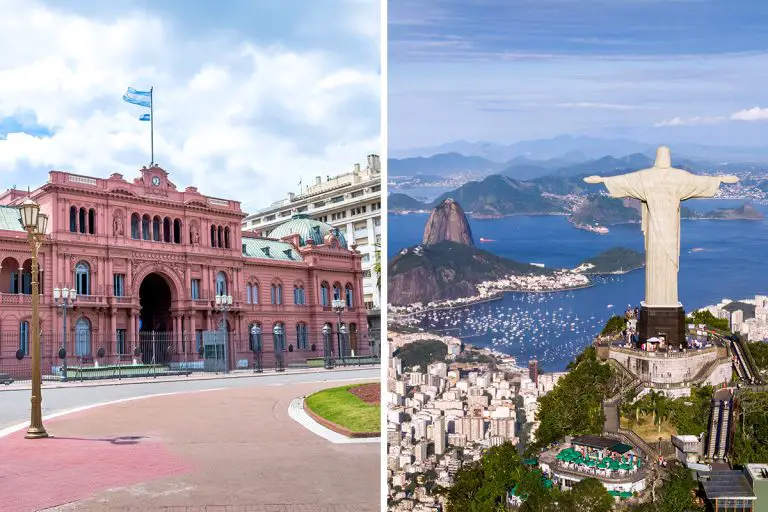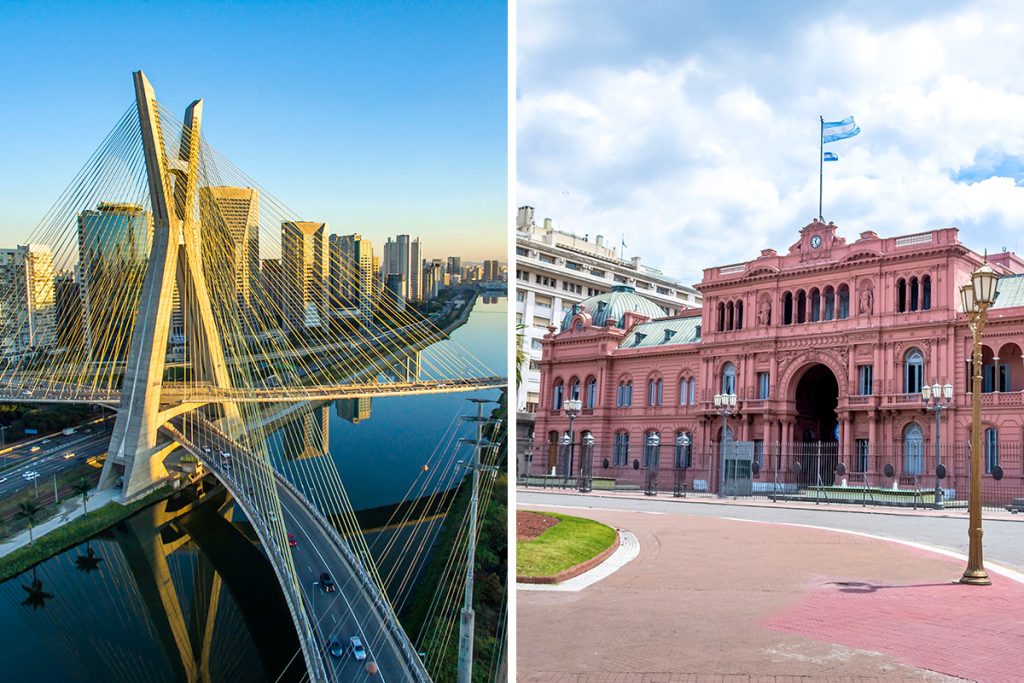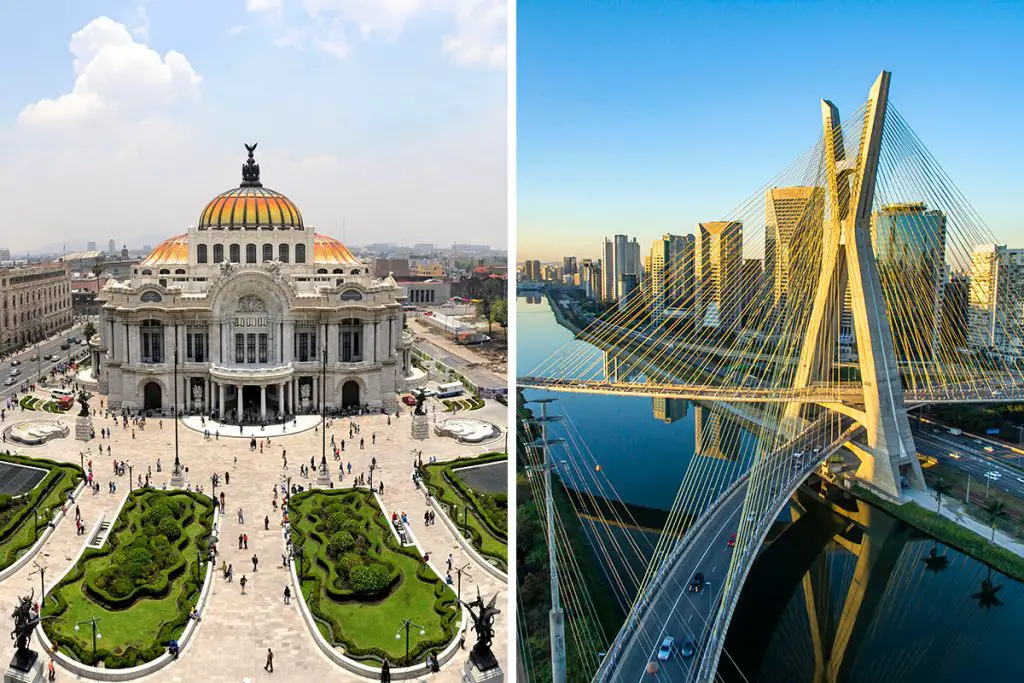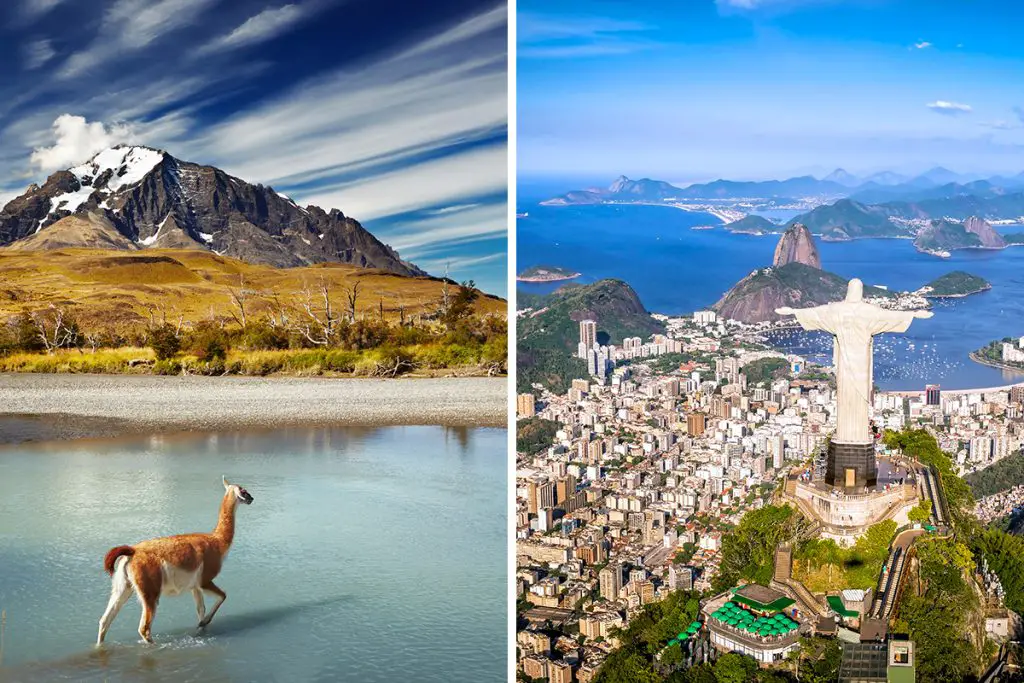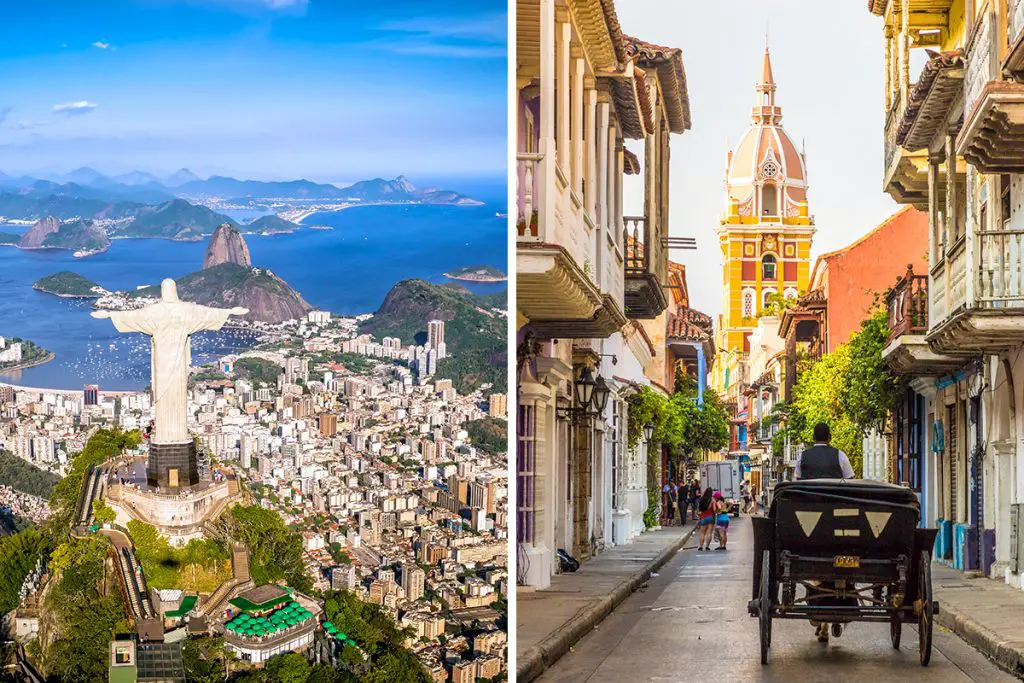Unveiling the stories of Buenos Aires and Rio de Janeiro, you embark on a tale of two cities, each with a distinct narrative spun through the ages. As you peel back the layers of history, architecture, and traditions, a richer understanding of these cities will emerge, painting your adventure with a deeper hue. Curious about how the old-world charm of Buenos Aires clashes and melds with the effervescent spirit of Rio de Janeiro? Keep reading to unearth the cultural gems that set them apart and yet, on some level, intertwine their fates.
History & Culture
Buenos Aires, with its European architectural silhouette and history intertwined with Spanish colonial pursuits, offers a unique blend of Latin American and European cultural threads. Your stroll through its avenues might feel like a journey back to a bygone era, with each corner whispering tales of a rich historical tapestry.
Rio de Janeiro, by contrast, is a spectacle of colors and sounds that resonate with the heartbeats of its indigenous roots and Portuguese colonial past. The city’s cultural narrative is an open book, with each neighborhood narrating a chapter full of life, diversity, and a sense of communal harmony.
Comparing the cultural dynamics, Buenos Aires leans more towards a formal and refined ethos, reflective of its European heritage. The city’s artistic and intellectual pursuits mirror the elegance and sophistication that define its social fabric.
On the other hand, Rio de Janeiro exudes a more relaxed, lively ambiance that is infectious to anyone who visits. The city’s ethos is a celebration of life, reflecting a community that thrives on social interactions, festivities, and a shared love for music and dance.
Summarizing this section, the historic and cultural exploration of Buenos Aires and Rio de Janeiro unveils a spectrum of experiences. While Buenos Aires offers a calm, refined exploration into a culturally rich past, Rio de Janeiro provides a lively, colorful voyage through a tapestry of communal narratives. Your choice between the two would hinge on whether you seek a tranquil retreat into history or a vibrant journey through a living, breathing cultural mosaic.
Attractions & Activities
When it comes to delving into the heart of Buenos Aires and Rio de Janeiro, the attractions and activities are as distinct as the rhythm of tango is from the beat of samba. Both cities beckon with a promise of unforgettable adventures, yet each offers a unique flavor of excitement.
In Buenos Aires, your steps might lead you to the historic neighborhood of San Telmo, where every stone and street echoes the city’s rich past. Here, the antique shops and traditional tango shows allow you to touch the essence of Argentine culture.
Furthermore, the architectural grandeur of buildings like the Palacio Barolo offers a taste of the city’s European heritage, making your exploration a blend of the old and new.
Contrarily, in Rio de Janeiro, the rhythm of the city takes you on a different kind of expedition. A visit to the iconic Christ the Redeemer statue not only gives a glimpse into the city’s spiritual fabric but also presents a panoramic view of Rio’s breathtaking landscape.
Moreover, a hike through the Tijuca National Park unveils a world where urban life merges with the wild, showcasing a harmonious blend of Rio’s vibrant city life and its lush natural surroundings.
While Buenos Aires invites a leisurely exploration of its cultural and architectural landmarks, Rio de Janeiro thrusts you into a more outdoorsy adventure, where each activity makes your heart race a bit faster with excitement. The former soothes with its classical music and tango shows, while the latter energizes with its hiking trails and panoramic views.
Summarizing, your inclinations will find a voice in either Buenos Aires or Rio de Janeiro. If a quiet, reflective exploration of culture and architecture sings to your soul, Buenos Aires awaits. Conversely, if your spirit seeks the thrill of breathtaking vistas and outdoor adventures, Rio de Janeiro is your calling.
Beaches
The coastal allure of Buenos Aires and Rio de Janeiro is like a rhythm that complements their city beats. The golden sands and the embrace of the vast oceans add a soothing undertone to the vibrant city life.
Buenos Aires, nestled by the Rio de la Plata, offers serene beach experiences like that at Reserva Ecológica Costanera Sur, where the calm waters stretch for 3.1 miles (5 km) offering a tranquil retreat from the city hustle. However, the waters here are not as inviting for a swim but provide a calm backdrop for a leisurely stroll or a quiet read.
In sharp contrast, Rio de Janeiro’s coastline is a spectacle of lively beaches like Copacabana and Ipanema, stretching over 2.2 miles (3.5 km) and 1.2 miles (2 km) respectively. Here, the azure waves invite you to dive into an invigorating ocean experience, while the sands hum with the life of beach sports and relaxation under the sun.
The tranquility of Buenos Aires’ shores reflects the quiet, contemplative nature of the city, offering a peaceful shore-side retreat. Meanwhile, the lively pulse of Rio de Janeiro’s beaches showcases a more energetic, social vibe where the city’s love for life spills over onto its sandy shores.
In summary, the beach experiences in Buenos Aires and Rio de Janeiro mirror their city vibes. Whether you seek a peaceful beach stroll in Buenos Aires or a lively beach day in Rio de Janeiro, the shores of these cities are ready to match your heartbeat.
Eating, Drinking & Nightlife
The culinary landscapes of Buenos Aires and Rio de Janeiro are as diverse and vibrant as the cities themselves. Each city holds a unique palette of flavors, ready to take you on a gastronomic journey full of delightful surprises.
In Buenos Aires, the aroma of grilling meat from the parrillas (grill houses) might be your first invitation to explore the city’s rich culinary scene. The Argentine love for beef is legendary, and a taste of their world-renowned steaks is a must. Here, the Italian and Spanish influences also whisper through, offering a variety of pizzas and pastas that are as authentic as they are delicious.
Transitioning to the libations, Buenos Aires showcases a wine culture that’s deeply rooted in its social fabric. Malbec, a red wine that’s as smooth as the tango, is a staple at most gatherings. The city’s cafes and bars resonate with a laid-back vibe, where conversations flow freely over a glass of wine or the traditional yerba mate.
Contrastingly, in Rio de Janeiro, the culinary scene dances to a more tropical tune. The city is a haven for seafood lovers, with dishes like moqueca (a Brazilian fish stew) showcasing the rich bounty of the sea. Açai bowls, fresh fruit juices, and coconut water further paint the city’s culinary canvas with vibrant colors.
The nightlife, however, turns the rhythm up a notch. In Rio, the night comes alive to the beat of samba. The lively atmosphere in Lapa or the sophisticated lounges in Ipanema offers a range of experiences, from energetic dance floors to chilled-out beachfront bars where the rhythm of the ocean accompanies your conversations.
Summarizing, Buenos Aires offers a culinary journey rich in traditional flavors with a European touch, paired with a calm, sophisticated drinking and nightlife scene. Rio de Janeiro, on the other hand, captivates with its tropical flavors, upbeat drinking spots, and nightlife that vibrates with the city’s energetic spirit.
Shopping
The shopping experience in Buenos Aires and Rio de Janeiro is a reflection of their cultural diversity and historical influences. Each city unfolds a unique shopping narrative that’s bound to satiate the desires of the curious traveler.
Buenos Aires, with its elegant boutiques and antique shops, offers a rich shopping experience. The city is known for its high-quality leather goods, which can be found in shops across neighborhoods like Palermo and Recoleta.
The weekend markets such as the Feria de San Telmo, brim with antiques, handmade crafts, and unique souvenirs, reflecting the city’s historical charm and artistic spirit.
On the contrary, Rio de Janeiro offers a more vibrant, open-air shopping ambiance. The Ipanema Hippie Fair and the Copacabana night market are iconic spots where local artisans display their crafts, from jewelry to artwork, allowing you a glimpse into the creative soul of the city.
The city’s shopping scene is a colorful blend of modern malls like Shopping Leblon and traditional markets, presenting a plethora of options to explore.
The shopping spree in Buenos Aires is more about discovering elegant boutiques, antique shops, and markets rich with historical and artistic finds. Whereas, in Rio de Janeiro, the shopping adventure is a lively blend of modern retail, traditional markets, and beachfront stalls, each narrating a tale of the city’s colorful and creative essence.
In conclusion, whether it’s the refined shopping avenues of Buenos Aires or the lively markets of Rio de Janeiro, each city promises a shopping experience that’s as unique and captivating as their cultural narratives.
Accommodation
Finding a place to rest your head after a day of exploration is essential, and both Buenos Aires and Rio de Janeiro offer a spectrum of accommodations that cater to different tastes and preferences.
In Buenos Aires, the lodgings often reflect the city’s European charm and historical elegance. Boutique hotels and classic apartments, especially in neighborhoods like Recoleta and Palermo, showcase a blend of modern amenities with a touch of Argentine tradition. Many of these places echo the city’s historical allure through their architecture and interior design.
Rio de Janeiro, on the other hand, boasts a variety of accommodations ranging from luxurious beachfront hotels in Copacabana to cozy hostels nestled in the vibrant neighborhoods of Lapa and Santa Teresa. The aesthetics here often capture the lively and colorful spirit of Brazil, offering a warm, welcoming ambiance.
The hospitality scene in Buenos Aires tends to lean towards a more traditional and elegant experience, while Rio de Janeiro offers a blend of luxury and casual comfort that resonates with the city’s lively atmosphere.
In summary, whether you desire a refined, tranquil setting in Buenos Aires or a lively, vibrant lodging experience in Rio de Janeiro, both cities provide a variety of accommodations that can cater to your preferences, making your stay a comfortable and enjoyable part of your journey.
Family-Friendliness & Children’s Activities
Traveling with family, especially with children, opens up a new spectrum of considerations and both Buenos Aires and Rio de Janeiro have a variety of offerings to keep the young ones engaged and entertained.
In Buenos Aires, family-friendly attractions like the Buenos Aires Zoo and interactive museums such as the Children’s Museum provide a blend of education and entertainment for children. The city’s numerous parks and open spaces like Bosques de Palermo also offer a great outdoor escape for families.
Rio de Janeiro, on the other hand, is a playground of natural attractions. The Tijuca National Park and the Jardim Botânico (Botanical Garden) provide ample space for children to explore and learn about the local flora and fauna. The city’s cable car ride to Sugarloaf Mountain is also a thrilling experience for children and adults alike.
Summarizing, Buenos Aires offers a structured, educational yet enjoyable experience for families, while Rio de Janeiro provides a more adventurous, nature-centric environment for children and families to explore, each creating a unique and enriching experience for young minds.
Getting There & Getting Around
Accessing and navigating through Buenos Aires and Rio de Janeiro form a part of the adventure, each city holding its unique transit narrative.
To reach Buenos Aires, international flights land at Ezeiza International Airport which is situated about 20 miles (32 km) from the city center. Once in the city, the subway system, known as Subte, along with buses and taxis, make navigating through Buenos Aires straightforward and convenient.
Rio de Janeiro welcomes its international visitors at Galeão International Airport, located 12 miles (19 km) north of downtown Rio. The city’s extensive bus system and metro offer convenient options for exploring the diverse neighborhoods and attractions.
When it comes to getting around, Buenos Aires has a well-structured public transport system, making it easy to traverse the city and explore its many neighborhoods. The extensive network of buses, subway lines, and taxis provides various options to suit your pace and preference.
In contrast, Rio de Janeiro offers a blend of public and private transport options. While the metro and buses are efficient for covering longer distances, bike rentals and walking are popular choices for exploring the city’s scenic landscapes and vibrant neighborhoods at a leisurely pace.
In summary, both Buenos Aires and Rio de Janeiro have well-connected transportation systems that ease the process of reaching and exploring these fascinating cities. Whether it’s the structured transit network of Buenos Aires or the blend of public and private transport options in Rio de Janeiro, your journey through these cities is set to be convenient and enjoyable.
Weather
The weather greatly influences the ambiance and experience of a city, and both Buenos Aires and Rio de Janeiro have their unique climatic personalities that shape the traveler’s journey.
Buenos Aires experiences a temperate climate with four distinct seasons. The summer months from December to February see temperatures ranging between 61°F to 86°F (16°C to 30°C), making the city warm and vibrant. The winter, spanning from June to August, is mild with temperatures fluctuating between 46°F to 59°F (8°C to 15°C), offering a cooler, serene atmosphere.
On the other hand, Rio de Janeiro has a tropical climate that’s warm year-round. The summer, from December to March, can get quite hot with temperatures often soaring to 95°F (35°C) or higher, though the average range is between 75°F to 85°F (24°C to 29°C).
The winter months from June to September are milder, with temperatures ranging from 65°F to 77°F (18°C to 25°C), providing a more comfortable atmosphere for exploration.
In summary, your choice between Buenos Aires and Rio de Janeiro could be swayed by your weather preference. Buenos Aires offers a blend of seasons, each carrying its charm, while Rio de Janeiro provides a perennial summer vibe that keeps the city lively and welcoming all year round.
Safety
Safety is a paramount consideration when exploring new destinations, and understanding the safety dynamics of Buenos Aires and Rio de Janeiro is crucial for a worry-free adventure.
Buenos Aires has its share of petty crimes like pickpocketing and bag-snatching, especially in crowded areas and public transport. Being vigilant and taking standard safety precautions can significantly reduce the risk of encountering such issues.
Similarly, Rio de Janeiro has challenges with petty crimes. Tourist areas are often targeted, so maintaining awareness and avoiding displaying valuables is advisable.
On a different note, Buenos Aires has a well-organized emergency service system, ensuring timely response in case of medical or other emergencies. Likewise, Rio de Janeiro has established emergency services, with numerous healthcare facilities equipped to handle various situations.
Summarizing, both cities necessitate a level of caution to ensure a safe and enjoyable experience. While petty crimes are present, taking precautionary measures and staying informed can contribute to a secure and memorable adventure in both Buenos Aires and Rio de Janeiro.
Cost
The cost of an adventure can significantly shape your experience, and comparing the expenses between Buenos Aires and Rio de Janeiro offers insight into budgeting for your journey.
In Buenos Aires, you may find that food, lodging, and transportation are relatively affordable. A decent meal can cost around 2400 Argentine Pesos (approximately USD 7), while a comfortable 3-star lodging option might go for 200 USD per night.
Transportation, with a variety of public and private options, offers budget-friendly choices, making moving around the city quite economical.
Rio de Janeiro, on the other hand, may present a slightly higher cost for similar amenities. Meals might cost around 35 Brazilian Reals (approximately USD 7), and lodging in a mid-range hotel averages 165 USD per night depending on the location and type of accommodation. Transportation costs are comparable to Buenos Aires, with a variety of options to suit different budgets.
Summarizing, Buenos Aires generally offers a more budget-friendly experience without compromising on the quality of food, lodging, and transportation. Rio de Janeiro, while slightly pricier, provides a variety of options to cater to different budget ranges, ensuring a fulfilling experience through the colorful and lively ambiance of the city.
Which Is Better – Buenos Aires or Rio de Janeiro?
Embarking on a quest to unearth the essence of Buenos Aires and Rio de Janeiro reveals a rich fabric of experiences, each city resonating with its distinct rhythm and color. Now, as we reflect upon the attributes of Buenos Aires and Rio de Janeiro, we aim to discern which city aligns with your quest for adventure.
Diving into the realm of history and culture, Buenos Aires enchants with its European charm and refined ethos, whereas Rio de Janeiro thrives on a vibrant, community-centered culture. The former invites a calm, intellectual exploration while the latter propels you into a lively, colorful cultural embrace.
The architectural grandeur of Buenos Aires contrasts with the rhythmic heartbeat of Rio de Janeiro, each narrative equally captivating yet distinct.
In the sphere of attractions and activities, Buenos Aires extends an invitation to delve into its historical neighborhoods and architectural marvels, offering a serene yet enriching exploration. Conversely, Rio de Janeiro propels you into an outdoor adventure, with its iconic landmarks and natural wonders offering a more energetic exploration.
The soothing shores of Buenos Aires provide a tranquil escape, while the lively beaches of Rio de Janeiro resonate with energy and social vibrancy. The choice between a peaceful beach stroll and an invigorating beach day marks the difference in the coastal allure of these cities.
As for gastronomy and nightlife, Buenos Aires offers a sophisticated culinary journey and a relaxed drinking culture, while Rio de Janeiro entices with tropical flavors and an energetic nightlife. The rhythm of the night in Rio de Janeiro vibrates with a lively spirit, contrasting with the calm, elegant evenings of Buenos Aires.
The retail therapy in Buenos Aires is about elegance and historical charm, whereas in Rio de Janeiro, it’s a vibrant, open-air market ambiance. The contrast between refined boutiques and lively markets defines the shopping experience in these cities.
In terms of accommodation, family-friendly activities, and transportation, both cities cater to a range of preferences. Buenos Aires generally presents a more structured, serene environment, while Rio de Janeiro provides a lively, adventurous setting.
Reflecting on the weather, safety, and cost, Buenos Aires offers a temperate climate, a level of vigilance for safety, and a budget-friendly experience. On the other hand, Rio de Janeiro, with its tropical climate, also necessitates caution for safety but might stretch your budget a bit further.
In conclusion, the choice between Buenos Aires and Rio de Janeiro hinges on personal preferences. If a serene, intellectual exploration amidst historical and architectural splendors entices you, Buenos Aires awaits. However, if a lively, outdoor adventure amidst vibrant culture and natural wonders calls out to you, Rio de Janeiro is your destination. Each city, with its unique offerings, stands ready to make your adventure an unforgettable tale.

